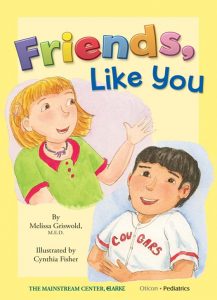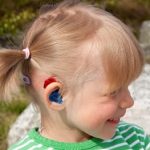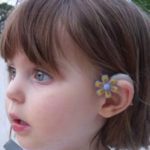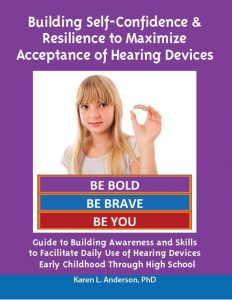Related Products
For Parents
Related Teacher Tools Takeout Items
Go-to Ideas for Supporting a Student’s Self-Concept
It can be tough being the only student using hearing devices and/or sign language in their grade or school. Teasing is a reality most children face, but those who are ‘different’ are teasing targets. What can we do to help strengthen self-concept in a setting where our kids are often made to feel different? This article shares some ideas for helping children with hearing loss feel good about themselves. READ MORE
Since 19 out of 20 children born with hearing loss are raised in families without members who are deaf or have hearing loss, it is likely that most children who are deaf/hard of hearing are the only ones in their family using hearing devices. Older brother has brown hair, sister has freckles, and the youngest child has hearing aids – hearing loss/deafness is just part of the aspects that make up the family. Most families adapt to the child’s needs by communicating within close proximity, carrying extra batteries, and checking that the child heard/understood directions, etcetera.
About the age of 4 years children begin to care about being liked by other children. Children with hearing devices entering preschool or kindergarten are very likely surrounded by peers who have never seen a hearing aid, BAHA, cochlear implant, or any kind of hearing assistance technology. Curiosity and questions are very normal.
 HOW the student reacts to these questions can set the tone, along with how the classroom teacher shares information with the large group about ‘different = okay’. If there is no preparation of the child for this situation, and no help by the teacher, then the student is at high risk for feeling it is not okay, or even bad, to be using hearing devices.
HOW the student reacts to these questions can set the tone, along with how the classroom teacher shares information with the large group about ‘different = okay’. If there is no preparation of the child for this situation, and no help by the teacher, then the student is at high risk for feeling it is not okay, or even bad, to be using hearing devices.
Wanting to be accepted by a group is typical throughout primary school. Our sense of self is influenced by the groups we belong to. Who we compare ourselves to can affect how we feel about ourselves, for better or worse. If the child does not encounter any other children in the group with hearing issues, then there is a subconscious message that to be able to belong, they shouldn’t use their hearing devices. This can be tough to counteract!
IDEA 1 – Read books with characters where the child can identify ‘he’s just like me!’.  These books can be read at home, long before the child starts school. SEE HERE FOR A LIST OF BOOKS. The characters may have dealt with teasing, or fitting in, or making friends. Books can introduce these concepts and open the door to discussions at home and at school. There are chapter books and young adult books that have characters with hearing loss too! Reading together, discussing ideas, and making the connection that other kids deal with being hard of hearing or deaf too, will strengthen the child or youth’s feelings that they are not alone, and that they are OKAY being a kid with hearing loss. A teacher reading a book that features a character with hearing loss to the whole class is a great way to start the early school years (suggestions: 1, 2, 3).
These books can be read at home, long before the child starts school. SEE HERE FOR A LIST OF BOOKS. The characters may have dealt with teasing, or fitting in, or making friends. Books can introduce these concepts and open the door to discussions at home and at school. There are chapter books and young adult books that have characters with hearing loss too! Reading together, discussing ideas, and making the connection that other kids deal with being hard of hearing or deaf too, will strengthen the child or youth’s feelings that they are not alone, and that they are OKAY being a kid with hearing loss. A teacher reading a book that features a character with hearing loss to the whole class is a great way to start the early school years (suggestions: 1, 2, 3).
IDEA 2 – Prepare for questions or teasing. Whether the child is 4, in 4th grade, or age 14, chances are that someone will make a comment about hearing issues or devices. Count on it.  Prepare for it. Humor, sarcasm, and yes – teasing, are all a part of language development and word play. Some children are raised in families where teasing happens and are likely to tease others – in a light-hearted manner, or not. Teasing can happen when someone feels threatened or upset, and they lash out at others.
Prepare for it. Humor, sarcasm, and yes – teasing, are all a part of language development and word play. Some children are raised in families where teasing happens and are likely to tease others – in a light-hearted manner, or not. Teasing can happen when someone feels threatened or upset, and they lash out at others.
| All of the reasons for teasing are NOT due to any fault of the child who is being teased – anyone can be teased or bullied. |
Finally teasing/bullying can occur as a way for a child to feel more powerful due to their own low self-esteem. The key is to not ‘feed’ the bully by tears, embarrassment, anger or any other negative reaction. Ignore the bully, or respond as matter of fact, i.e., ‘I know’, ‘You told me that yesterday’, ‘Yeah I wear hearing aids.’ Role playing to practice responses is vital. For preschoolers and kindergarten students, practice ways they can respond to questions like, “What are those things?” “Why do you wear that thing?”. Kids are curious and the child needs to be prepared to provide simple answers!
IDEA 3 – Connect kids with other kids who use hearing devices and/or sign.
The most POWERFUL tool we have to increase self-concept, create a strong and healthy identity that it is ‘okay to be a kid with hearing loss’ is to foster the feeling that the child is part of a group of ‘cool kids with hearing aids’ or other devices, and/or ‘cool kids who sign’.

 Play dates or Zoom chats arranged by the family are fabulous! Working on self-advocacy skill development in school where students from a number of buildings can join in virtually to learn strategies, discuss issues, and realize they are not alone – terrific! Both family and school connections – AWESOME!
Play dates or Zoom chats arranged by the family are fabulous! Working on self-advocacy skill development in school where students from a number of buildings can join in virtually to learn strategies, discuss issues, and realize they are not alone – terrific! Both family and school connections – AWESOME!
Starting with ages 4-5 and going all the way through high school, opportunities to connect, complain, strategize, and celebrate cannot be underestimated in their overall effect on self-concept, less rejection of using hearing devices, greater motivation to self-advocate, and more!

Want to learn more? Check out Building Self-Confidence & Resilience to Maximize Acceptance of Hearing Devices available inexpensively in print from Supporting Success or digitally from Teacher Tools Takeout.
Author: Karen Anderson
